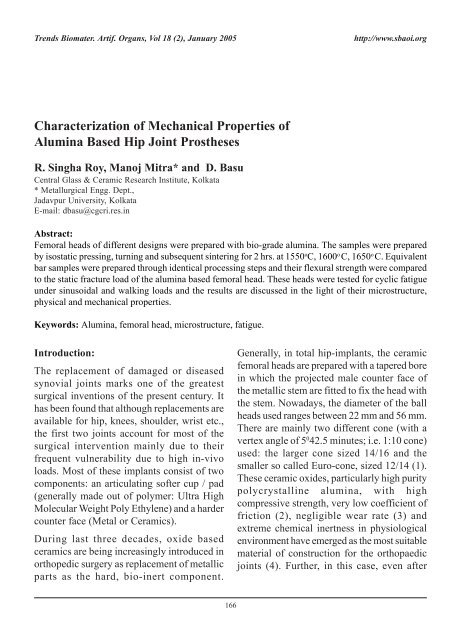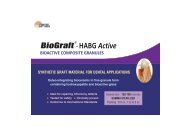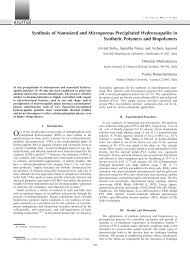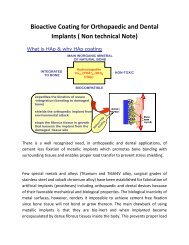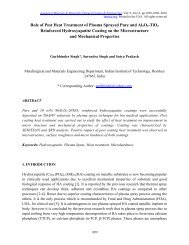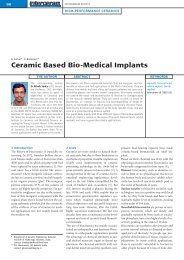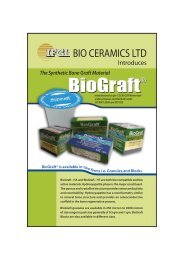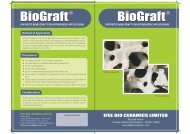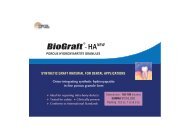Characterization of Mechanical Properties of Alumina ... - medIND
Characterization of Mechanical Properties of Alumina ... - medIND
Characterization of Mechanical Properties of Alumina ... - medIND
You also want an ePaper? Increase the reach of your titles
YUMPU automatically turns print PDFs into web optimized ePapers that Google loves.
Trends Biomater. Artif. Organs, Vol 18 (2), January 2005<br />
http://www.sbaoi.org<br />
<strong>Characterization</strong> <strong>of</strong> <strong>Mechanical</strong> <strong>Properties</strong> <strong>of</strong><br />
<strong>Alumina</strong> Based Hip Joint Prostheses<br />
R. Singha Roy, Manoj Mitra* and D. Basu<br />
Central Glass & Ceramic Research Institute, Kolkata<br />
* Metallurgical Engg. Dept.,<br />
Jadavpur University, Kolkata<br />
E-mail: dbasu@cgcri.res.in<br />
Abstract:<br />
Femoral heads <strong>of</strong> different designs were prepared with bio-grade alumina. The samples were prepared<br />
by isostatic pressing, turning and subsequent sintering for 2 hrs. at 1550 o C, 1600 o C, 1650 o C. Equivalent<br />
bar samples were prepared through identical processing steps and their flexural strength were compared<br />
to the static fracture load <strong>of</strong> the alumina based femoral head. These heads were tested for cyclic fatigue<br />
under sinusoidal and walking loads and the results are discussed in the light <strong>of</strong> their microstructure,<br />
physical and mechanical properties.<br />
Keywords: <strong>Alumina</strong>, femoral head, microstructure, fatigue.<br />
Introduction:<br />
The replacement <strong>of</strong> damaged or diseased<br />
synovial joints marks one <strong>of</strong> the greatest<br />
surgical inventions <strong>of</strong> the present century. It<br />
has been found that although replacements are<br />
available for hip, knees, shoulder, wrist etc.,<br />
the first two joints account for most <strong>of</strong> the<br />
surgical intervention mainly due to their<br />
frequent vulnerability due to high in-vivo<br />
loads. Most <strong>of</strong> these implants consist <strong>of</strong> two<br />
components: an articulating s<strong>of</strong>ter cup / pad<br />
(generally made out <strong>of</strong> polymer: Ultra High<br />
Molecular Weight Poly Ethylene) and a harder<br />
counter face (Metal or Ceramics).<br />
During last three decades, oxide based<br />
ceramics are being increasingly introduced in<br />
orthopedic surgery as replacement <strong>of</strong> metallic<br />
parts as the hard, bio-inert component.<br />
Generally, in total hip-implants, the ceramic<br />
femoral heads are prepared with a tapered bore<br />
in which the projected male counter face <strong>of</strong><br />
the metallic stem are fitted to fix the head with<br />
the stem. Nowadays, the diameter <strong>of</strong> the ball<br />
heads used ranges between 22 mm and 56 mm.<br />
There are mainly two different cone (with a<br />
vertex angle <strong>of</strong> 5 0 42.5 minutes; i.e. 1:10 cone)<br />
used: the larger cone sized 14/16 and the<br />
smaller so called Euro-cone, sized 12/14 (1).<br />
These ceramic oxides, particularly high purity<br />
polycrystalline alumina, with high<br />
compressive strength, very low coefficient <strong>of</strong><br />
friction (2), negligible wear rate (3) and<br />
extreme chemical inertness in physiological<br />
environment have emerged as the most suitable<br />
material <strong>of</strong> construction for the orthopaedic<br />
joints (4). Further, in this case, even after<br />
166
<strong>Characterization</strong> <strong>of</strong> <strong>Mechanical</strong> <strong>Properties</strong> <strong>of</strong> <strong>Alumina</strong> Based Hip Joint Prostheses<br />
prolonged usage the amount <strong>of</strong> alumina debris<br />
released in the body from the articulating<br />
surface is negligible and as a result the<br />
associated problems are eliminated. It has been<br />
reported (5) that in pure and dense alumina<br />
only a very thin [less than 50 Å thickness ]<br />
hydrated layer <strong>of</strong> Al(OH) 3<br />
is formed on the<br />
surface in contact with body fluid which acts<br />
as the intermediate lubricating layer between<br />
implant components and reduces wear <strong>of</strong> the<br />
polymer in the ceramic-polymer interface.<br />
The present paper deals with the in-vitro<br />
characterization techniques <strong>of</strong> alumina based<br />
femoral heads <strong>of</strong> the bi-modular total hip<br />
prosthesis, sintered at three different<br />
temperatures and correlate their physical and<br />
mechanical properties with the corresponding<br />
microstructure. The results <strong>of</strong> the fracture and<br />
fatigue behaviour <strong>of</strong> these ceramic heads under<br />
different dynamic conditions are also<br />
discussed and compared with their mechanical<br />
properties obtained through the corresponding<br />
bar samples.<br />
Materials and methods:<br />
Commercially available fine grained alumina<br />
with 99.8 % purity (A-16 SG grade <strong>of</strong> Alcoa<br />
USA) was used for this study. The chemical<br />
analysis <strong>of</strong> the powder is given in Table 1.<br />
Table 1: Chemical composition <strong>of</strong> alumina<br />
powder used for the experiments.<br />
Al 2<br />
O 3<br />
99.8 %<br />
Na 2<br />
O 0.06 %<br />
Fe 2<br />
O 3<br />
0.02 %<br />
MgO 0.03 %<br />
SiO 2<br />
0.03 %<br />
CaO 0.02 %<br />
The powder was pressed isostatically at a<br />
pressure <strong>of</strong> 150 MPa to dense cylindrical<br />
shapes by using a Cold Isostatic Press supplied<br />
by EPSI N.V., SO 10036, Belgium. The<br />
pressed green cylinders were pre-sintered at<br />
800 0 C and subsequently turned in CNC (Make:<br />
Praga Tools India Ltd., Secunderabad, model<br />
no. 342) to get the pre-fixed design <strong>of</strong> the<br />
femoral heads with an accuracy <strong>of</strong> + 5 micron.<br />
The turned items were thereafter sintered for<br />
2 hrs at three different sintering temperatures<br />
(1550, 1600 and 1650 o C), ground and polished<br />
with diamond paste <strong>of</strong> progressively reducing<br />
grit size to obtain surface finish (R a<br />
) below<br />
0.05 micron as measured by a pr<strong>of</strong>ilometer<br />
(Surtronic 3p, Form Talysurf Plus, Rank<br />
Taylor Hobson Ltd, U.K.). A typical ceramic<br />
headed hip-implant used in the study along<br />
with a schematic elaboration <strong>of</strong> the fixation<br />
system between the ball and the stem is<br />
presented in Fig 1. The taper design followed<br />
here was standard 12/14 Euro-cone with a<br />
taper angle <strong>of</strong> 5.42 0 in accordance with the<br />
German standard specifications DIN 254 and<br />
DIN ISO 3040.<br />
Fig 1: Design <strong>of</strong> the alumina balls with 12/14<br />
taper (1:10 Euro-cone) used in the study<br />
167
R. Singha Roy, Manoj Mitra* and D. Basu<br />
The spherecity <strong>of</strong> the balls was measured by a<br />
Coordinate Measuring Machine manufactured<br />
by Carl Zeiss, GmbH, model no. 850 and the<br />
spherecity values were always kept below 10<br />
micron (6). The overall manufacturing process<br />
is outlined in Fig. 2. In addition, no. <strong>of</strong> bar<br />
(45 x 4.5 x 3.5 mm 3 ) and plate (25 x 25 x 2<br />
mm 3 ) shaped test samples were also prepared<br />
in identical way as adapted for the balls for<br />
determination <strong>of</strong> different typical physical and<br />
mechanical properties <strong>of</strong> the material.<br />
The X-ray diffraction <strong>of</strong> the sintered alumina<br />
samples were performed by using Philips<br />
PW1710 based X-Ray B.V. Diffractometer in<br />
flat plate geometry using monochromatic Cu<br />
K á1<br />
radiation (wavelength: 1.54056 Å ) at 55<br />
mA and 40 KV. The 3-point flexural strength<br />
<strong>of</strong> the bar samples and the static fracture test<br />
<strong>of</strong> the alumina femoral heads were conducted<br />
by Instron made Universal Testing Machine,<br />
model 5500 R 1185, U.K. For determination<br />
<strong>of</strong> 3-point flexural strength ASTM<br />
specifications (7) were followed and<br />
accordingly, 10 nos. <strong>of</strong> alumina bars were<br />
tested for generation <strong>of</strong> single data-point. The<br />
strength values (σ) <strong>of</strong> the samples were<br />
calculated from the following relationship:<br />
σ = 3wl / 2bd 2 …………………………(1)<br />
where w is the braking load, l is the distance<br />
between the two support rollers, b and d are<br />
the width and thickness <strong>of</strong> the respective<br />
sample.<br />
One mechanical hardness tester, supplied by<br />
INSTRON WOLPERT, GmbH (model no.<br />
DIA TESTOR 7021) was employed to<br />
determine Vicker’s hardness and mode-I<br />
fracture toughness <strong>of</strong> the sintered samples.<br />
Vicker’s hardness (H v<br />
) was determined from<br />
the diagonals <strong>of</strong> the hardness impression (a<br />
typical hardness impression is shown in fig.<br />
3) from the following relationship:<br />
H v<br />
= 2P sin68 o / d 2 ……………………….(2)<br />
Where P is the indentation load and d is the<br />
size <strong>of</strong> the diagonal <strong>of</strong> the impression.<br />
Fig 2: Flow diagram <strong>of</strong> manufacturing<br />
<strong>of</strong> alumina based femoral head<br />
168
<strong>Characterization</strong> <strong>of</strong> <strong>Mechanical</strong> <strong>Properties</strong> <strong>of</strong> <strong>Alumina</strong> Based Hip Joint Prostheses<br />
Fig 3: Impression produced by Vicker’s<br />
Indentation at a load <strong>of</strong> 100 N showing the cracks<br />
originated from the end <strong>of</strong> the diagonal<br />
The mode-I fracture toughness (K 1c<br />
) <strong>of</strong> the<br />
samples were calculated from the crack lengths<br />
generated from the corners <strong>of</strong> the impression<br />
by using the equation (3) as follows (8 - 9):<br />
K IC<br />
= 0.016 PC -3/2 (E/H v<br />
) 1/2 ……………(3)<br />
Where the indentation load P was kept as 100<br />
N, 2C was the total crack length, H v<br />
was the<br />
Vicker’s hardness and E was the elastic<br />
modulus <strong>of</strong> alumina which was taken as 380<br />
GPa as determined by adapting ultrasonic<br />
pulse-echo technique the details <strong>of</strong> which has<br />
been published else where (9 - 10).<br />
For fracture study under static load, the<br />
polished balls (sintered at 1550 0 C and 1600 0 C),<br />
with two different diameters (28 mm and 32<br />
mm) were press-fitted with a stainless steel<br />
tapered counterpart as recommended by ISO<br />
7206-5 (9). Accordingly 20 nos. <strong>of</strong> balls from<br />
each group were subjected to static fracture<br />
test and the average values along with the<br />
associated scatter were recorded. The fatigue<br />
behaviour <strong>of</strong> the identical alumina balls was<br />
studied under dynamic fatigue loading by<br />
using an Instron made ‘Hip Joint Simulator’<br />
(model no. 8511.20). Each <strong>of</strong> the balls fitted<br />
with 316L stainless steel stem were subjected<br />
to compression-compression loading cycle<br />
against a UHMWPE (Ultra High Molecular<br />
Weight Polyethylene) acetabular cup. The cup<br />
was programmed to undergo a rocking motion<br />
<strong>of</strong> 10 0 on each side <strong>of</strong> the center line <strong>of</strong> the<br />
ram to simulate walking load pattern within a<br />
human body. The load cycle applied was<br />
identical to that experienced by a normal hip<br />
<strong>of</strong> a person with a body weight <strong>of</strong> 100 kg as<br />
shown in Fig 4. In each case, the test was<br />
continued up to 10 6 cycles and the progressive<br />
change in pattern <strong>of</strong> the load-time curve was<br />
noted. Microstructure <strong>of</strong> the polished and<br />
thermally etched samples were studied by<br />
employing one Scanning Electron Microscope<br />
(SEM),”LEO 430i STEROSCAN, U.K.”<br />
Fig 4: Load cycle applied on the alumina balls<br />
during dynamic fatigue testing<br />
Results and discussion:<br />
The XRD pattern obtained from the sintered<br />
plate sample sintered at 1550 o C is shown in<br />
Fig 5. The result revealed that α-alumina (i.e.<br />
most stable phase <strong>of</strong> alumina) is almost the<br />
only major phase in all the samples. Presence<br />
<strong>of</strong> any other secondary phases could not be<br />
detected in any sample with the facilities<br />
available for the present study.<br />
169
R. Singha Roy, Manoj Mitra* and D. Basu<br />
Fig 5: XRD <strong>of</strong> the sintered alumina<br />
used in the experiment<br />
The overall results <strong>of</strong> the physical and<br />
mechanical properties <strong>of</strong> the material are<br />
summarized in Table 2.<br />
Table 2: <strong>Mechanical</strong> properties <strong>of</strong> the alumina<br />
samples sintered at different temperatures<br />
Figure 6 a, b and c represent the microstructure<br />
<strong>of</strong> the sintered samples obtained by thermal<br />
etching. The photomicrographs clearly<br />
indicate that the grain size <strong>of</strong> the samples<br />
progressively increases with increase in<br />
sintering temperature. The increase in grain<br />
size has inversely affected the strength and<br />
other mechanical properties <strong>of</strong> the material<br />
which is in agreement with the findings<br />
reported in the literature (12 - 13). The average<br />
grain size as measured by the line intercept<br />
method (ASTM E112) indicate that the<br />
increase <strong>of</strong> sintering temperature from 1550 o<br />
to 1600 o C has only a marginal effect on grain<br />
growth within the samples and the average<br />
grain size increased from 2 to 4 micron.<br />
However, it may be noted in fig. 6b that the<br />
samples sintered at 1600 0 C, had few large<br />
grains surrounded by no. <strong>of</strong> small grains,<br />
whereas in the other ones, the microstructure<br />
was more or less homogenous (fig. 6a) and<br />
this might have resulted much higher<br />
mechanical strength for this set <strong>of</strong> materials.<br />
Increase in sintering temperature to 1650 o C<br />
increased the average grain size to about 7<br />
micron and this affected the mechanical<br />
properties even further.<br />
The results <strong>of</strong> the static fracture test (as shown<br />
in Table 3) also presented a similar trend. The<br />
fracture load went on increasing with decrease<br />
in grain size as was evident in the previous<br />
case. In case <strong>of</strong> the heads with 28 mm diameter<br />
the strength increased from 20 KN to 25 KN<br />
as the average grain size varied from 4 to 2<br />
micron while in the other set <strong>of</strong> balls the values<br />
changed from 40 to 50 KN exhibiting an<br />
identical change <strong>of</strong> 25% in both the cases. In<br />
case <strong>of</strong> flexural strength this change was<br />
however much lower and was restricted only<br />
to about 10%. As per FDA guidelines (14) the<br />
average fracture load <strong>of</strong> the balls should<br />
exceed 46 KN and no ball should fail at less<br />
than 20 KN and this has been achieved for<br />
femoral heads with 32 mm diameter, sintered<br />
at 1550 o C.<br />
Fig 6a: Microstructure <strong>of</strong> the<br />
alumina sintered at 1550 0 C<br />
170
<strong>Characterization</strong> <strong>of</strong> <strong>Mechanical</strong> <strong>Properties</strong> <strong>of</strong> <strong>Alumina</strong> Based Hip Joint Prostheses<br />
Fig 6b: Microstructure <strong>of</strong> the alumina<br />
sintered at 1600 0 C<br />
Fig 6c: Microstructure <strong>of</strong> the alumina<br />
sintered at 1650 0 C<br />
Under dynamic fatigue loading the progressive<br />
displacement <strong>of</strong> the ball from its initial position<br />
under identical stress situation has been<br />
reported in Fig 7. It may be noted that the total<br />
displacement <strong>of</strong> the ball was the simultaneous<br />
and cumulative effect <strong>of</strong> (i) the changes in the<br />
relative position between the ball and the<br />
stainless stem due to deformation/ wear <strong>of</strong><br />
the metallic component, (ii) the deformation<br />
<strong>of</strong> the polymer cup, and (iii) the wear <strong>of</strong> the<br />
polymer cup due to continuous articulation<br />
against the harder alumina surface.<br />
Fig 7: Instantaneous position <strong>of</strong> the tip <strong>of</strong> the ball<br />
during any cycle when tested with rocking motion<br />
due to combined effect <strong>of</strong> the Polymer cup<br />
deformation, Wear <strong>of</strong> the polymer cup and the<br />
deformation <strong>of</strong> the stainless steel stem<br />
To identify and separate the effect <strong>of</strong> these<br />
different influencing parameters, a polished<br />
metallic plate was placed on the acetabular cup<br />
and the position <strong>of</strong> the ceramic head before<br />
and after the experiment was noted when it<br />
touched the top surface <strong>of</strong> the plate and from<br />
the difference the relative positional shift<br />
within the head and stem assembly was<br />
measured. In all the cases, this shift was found<br />
to be negligible which in turn confirmed the<br />
suitability <strong>of</strong> the fitting arrangement. Further<br />
to separate the effect <strong>of</strong> deformation from the<br />
wear <strong>of</strong> the polymer based accetabular cup,<br />
each <strong>of</strong> the experiments was performed twice:<br />
i) once the ceramic head was loaded along with<br />
a synchronized rocking motion <strong>of</strong> the<br />
acetabular cup and ii) the loading was without<br />
rocking motion. In the first case, the ball<br />
displacement represented the combined effect<br />
<strong>of</strong> wear and deformation <strong>of</strong> the polymer cup,<br />
while in the second one, as there was no<br />
relative motion between the two components,<br />
the displacement <strong>of</strong> the head only represented<br />
the deformation <strong>of</strong> the polymer cup. The<br />
results as summarized in Fig 8, show that a<br />
the rate <strong>of</strong> deformation <strong>of</strong> the polymer cup<br />
decreases with time and after 2 x 10 5 cycles,<br />
171
R. Singha Roy, Manoj Mitra* and D. Basu<br />
almost no further deformation was noticed.<br />
However, the wear <strong>of</strong> the polymer- cup<br />
continued though the overall wear was<br />
negligible, the rate was marginal and decreased<br />
with time. During the study none <strong>of</strong> the<br />
ceramic head failed and the post experiment<br />
microstructure did not reveal any change in<br />
defect concentration.<br />
Fig 8: Time dependent displacement <strong>of</strong> the tip<br />
<strong>of</strong> the ball for both the cases<br />
[i.e. i) with rocking motion and<br />
ii) without rocking motion]<br />
The fatigued heads were compressed to<br />
fracture and the average fracture load was<br />
observed to be almost identical with the<br />
corresponding values obtained from the fresh<br />
samples as reported in Table 3.<br />
Table 3: Static Fracture Load <strong>of</strong> the<br />
alumina based femoral heads<br />
This confirms that the dynamic fatigue loading<br />
did not change the existing crack dimensions<br />
within the samples which in turn indicate that<br />
even for a person with the bodyweight <strong>of</strong> 100<br />
kg, the stresses experienced were below the<br />
threshold fatigue limit <strong>of</strong> the material and<br />
therefore a long and safe performance is<br />
expected.<br />
Conclusion:<br />
<strong>Alumina</strong> based femoral heads with 28 and 32<br />
mm diameter and 12/14 taper and 1: 10 Eurocone<br />
(i.e. with a taper angle <strong>of</strong> 2.85 0 ) could be<br />
developed as per international standards. The<br />
actual components and the identically prepared<br />
test samples were mechanically characterized<br />
and the results were compared and discussed<br />
from the angle <strong>of</strong> their respective<br />
microstructure. The mechanical properties <strong>of</strong><br />
the material were found to decrease with the<br />
increase in sintering temperature and grainsize.<br />
The results <strong>of</strong> the dynamic fatigue study<br />
revealed all the femoral heads withstood the<br />
cyclic stress parameters experienced by a<br />
normal hip <strong>of</strong> a person <strong>of</strong> 100 kg body weight<br />
without any degradation. The associated creep<br />
and wear <strong>of</strong> the polymer based acetabular cup<br />
was also determined and the values were found<br />
to be extremely low which in turn indicated<br />
that hip-joints developed from this material<br />
combination is ideally suitable for clinical<br />
application in human patients up to a body<br />
weight <strong>of</strong> 100 kg.<br />
172
<strong>Characterization</strong> <strong>of</strong> <strong>Mechanical</strong> <strong>Properties</strong> <strong>of</strong> <strong>Alumina</strong> Based Hip Joint Prostheses<br />
References:<br />
1. E. Doerre, H. Beutter, D. Geduldig, Anforderungen an keramische werkst<strong>of</strong>fe als biomaterial<br />
fuer kuenstliche gelenke, Arch. Orthop. Unfallchir (in German), Vol. 83, 269 (1975).<br />
2. H. McKellop, I. Clarke, K. Markolf, H. Amstutz, Friction and wear properties <strong>of</strong> polymer,<br />
metal and ceramic prosthetic materials evaluated on a multichannel screening device, J.<br />
Biomed. Mater. Res., Vol. 15, 619 (1981).<br />
3. P. Boutin, THR using alumina – alumina sliding and metallic stem : 1330 cases on 11 year<br />
follow up, in Orthopaedic Ceramic Implants, Proc. Jap. Soc. Orthop. Ceram. Implants, Eds.<br />
H. Oonishi and K. Ooi, Osaka, Japan, Vol. 1, 11 (1981).<br />
4. F. D. Williams, Fundamental aspects <strong>of</strong> biocompatibility, Ed. F. D. Williams, Bocaraton F1<br />
CRC Press Vol. 1, 67 (1981).<br />
5. G. Willmann, Mater. wiss. Werkst. tech., Vol. 24, 315 (1993).<br />
6. ASTM F2033 – 00a, Standard Specification for Total Hip Joint Prosthesis and<br />
Endoprosthesis Bearing Surfaces Made <strong>of</strong> Metallic, Ceramic and Polymeric Materials, 1<br />
(2001).<br />
7. ASTM C1161 – 94, Standard test method for Flexural Strength <strong>of</strong> Advanced Ceramics at<br />
Ambient Temperature, Vol. 15.01 (1996).<br />
8. G. R. Antis, P. Chantikul, B. R. Lawn, D. B. Marshall, A critical evaluation <strong>of</strong> indentation<br />
techniques for determining fracture toughness: I, direct crack measurement., J. Am.<br />
Ceram. Soc., Vol. 64, 533 (1981).<br />
9. D. Basu, S. Mukherjee, K. K. Phani, Non-destructive characterization <strong>of</strong> zirconia toughened<br />
alumina ceramics using ultrasonics’, J. <strong>of</strong> Mater. Sci., Vol. 31(3), 1021 (1996).<br />
10. K. K. Phani, Porosity dependence <strong>of</strong> elastic properties and ultrasonic velocity in<br />
polycrystalline alumina – a model based on cylindrical pores, J. <strong>of</strong> Mater. Sci.,Vol. 31<br />
(1), 262 (1996).<br />
11. ISO 7206 – 5, Determination <strong>of</strong> Resistance to Static Load <strong>of</strong> Head and Neck Region <strong>of</strong><br />
Stemmed Femoral Components, 1 (1992).<br />
12. P. Chantikul, S. J. Benninson, B. R. Lawn, Role <strong>of</strong> grain size in the strength and R-curve<br />
properties <strong>of</strong> alumina., J. Am. Ceram. Soc., Vol. 73(8), 2419 (1990).<br />
13. R.M. Springgs, J.B. Mitchell, T. Vasilos, <strong>Mechanical</strong> properties <strong>of</strong> pure, dense Aluminium<br />
oxide as a function <strong>of</strong> temperature and grain size’, J. Am. Ceram. Soc.,Vol. 47(7), 323 (1964).<br />
14. FDA (U.S. Food and Drug Administration), Guidance Document For The Preparation <strong>of</strong><br />
Premarket Notifications for Ceramic Ball Hip Systems, 1 (1995).<br />
173


